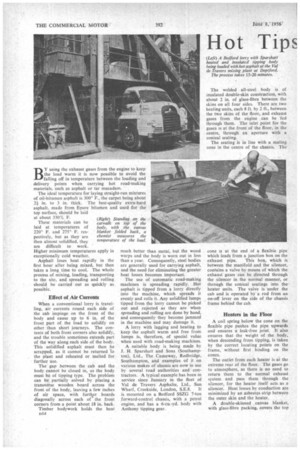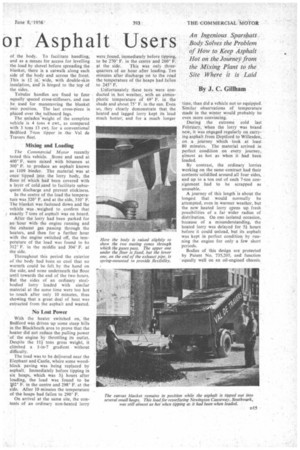Hot Tips or. Asphalt Users
Page 68

Page 69

If you've noticed an error in this article please click here to report it so we can fix it.
An Ingenious Sparshatt Body Solves the Problem of How to Keep Asphalt Hot on the Journey from the Mixing Plant to the Site Where it is Laid By J. C. Giltham
BY using the exhaust gases from the engine to keep the load warm it is now possible to avoid the falling off in temperature between the loading and delivery points when carrying hot road-making materials, such as asphalt or tar macadam.
The ideal temperature for laying straight-run mixtures of oil-bitumen asphalt is 300° F., the carpet being about 21 in. to 3 in. thick. The best-quality extra-hard asphalt, made from Epure bitumen and used for the top surface, should be laid at about 330% F.
These materials can be laid at temperatures of 220° F. and 275° F. respectively, but as they are then almost solidified, they are difficult to work. Higher minimum temperatures apply in exceptionally cold weather.
Asphalt loses heat rapidly in the first hour after being mixed, but then takes a long time to cool. The whole process of mixing, loading, transporting to the site, and spreading and rolling should be carried out as quickly as possible.
Effect of Air Currents
When a conventional lorry is travelling, air currents round each side of the cab impinge on the front of the body and cause up to 6 in. of the front part of the load to solidify on other than short journeys. The contents of both front corners also solidify, and the trouble sometimes extends part of the way along each side of the body. This solidified asphalt must then be scrapped, as it cannot be returned to the plant and reheated or melted for further use.
The gap between the cab and the body cannot be closed in, as the body must be of tipping type. The problem can be partially solved by placing a transverse wooden board across the front of the body, leaving a few inches of air space, with furtker boards diagonally across each of the front corners from a point about 18 in. back.
Timber bodywork holds the heat nI4 much better than metal, but the wood warps and the body is worn out in less than a year. Consequently, steel bodies are generally used for carrying asphalt, and the need for eliminating The greater heat losses becomes important.
The use of automatic road-making machines is spreading rapidly. Hot asphalt is tipped from a lorry directly into the machine, which spreads it evenly and rolls it. Any solidified lumps tipped from the lorry cannot be picked out and rejected as they are when spreading and rolling are done by hand, and consequently they become jammed in the machine and may damage it.
A lorry with lagging and heating to keep the asphalt warm and free from lumps is, therefore, of special value when used with road-making machines.
A suitable body is being made by J. H. Sparshatt and Sons (Southampton), Ltd., The Causeway, Redbridge, Southampton, and examples of it on various makes of chassis are now in use by several road authorities and contractors. A typical example has been in service since January in the fleet of Val de Travers Asphalte, Ltd., Sun Wharf, Creekside, London, S.E.8. It is mounted on a Bedford SSZG 7-ton forward-control chassis, with a petrol engine, and has a 6-cu.-yd. body with Anthony tipping gear. The welded all-steel body is of insulated double-skin construction, with about 2 in. of glass-fibre between the skins on all four sides. There are two heating units, each 8 ft. by 2 ft., between the two skins of the floor, and exhaust gases from the engine can be fed through them. The inlet point for the gases is at the front of the floor, in the centre, through an aperture with a conical seating.
The seating is in line with a mating cone in the centre of the chassis. The cone is at the end of a flexible pipe which leads from a junction box on the exhaust pipe. This box, which is between the manifold and the silencer, contains a valve by means of which the exhaust gases can be directed through the silencer in the normal manner, or through the conical seatings into the heater units. The valve is under the cab and is operated by a rod from an on-off lever on the side of the chassis frame behind the cab.
Heaters in the Floor
A coil spring below the cone on the flexible pipe pushes the pipe upwards and ensures a leak-free joint. It also ensures that the weight of the body, when descending from tipping, is taken by the correct locating points on the frame, without first binding on the cones.
The outlet from each heater is at the extreme rear of the floor. The gases go to atmosphere, as there is no need to return them to the normal exhaust system and pass them through the silencer, for the heater itself acts as a silencer. Heat losses by conduction are minimized by an asbestos strip between the outer skin and the heater.
A double-skinned canvas blanket, with glass-fibre packing, covers the top
of the body. To facilitate handling, and as a means for access for levelling the load by shovel before spreading the blanket, there is a catwalk along each side of the body and across the front. This is 12 in wide, with double-skin insulation, and is hinged to the top of the sides.
Tubular handles are fixed to four equally spaced cross-stiffeners, and can be used for manoeuvring the blanket into position. The last cross-piece is placed over the tailboard lugs.
The unladen weight of the complete vehicle is 4 tons 4 cwt., as compared with 3 tons 13 cwt. for a conventional Bedford 7-ton tipper in the Val de Travers fleet.
Mixing and Loading
The Commercial Motor recently tested this vehicle. Stone and sand at 400° F. were mixed with bitumen at 300° F. to produce an asphalt known as 1.109 binder. The material was at once tipped into the lorry body, the floor Of which had been covered with a layer of cold sand to facilitate subsequent discharge and prevent stickiness.
In the centre of the load the temperature was 320° F. and at the side, 310° F. The blanket was fastened down and the vehicle was weighed to confirm that exactly 7 tons of asphalt was on board.
After the lorry had been parked for an hour with the engine running and the exhaust gas passing through the heaters, and then for a further hour with the engine switched off, the temperature of the load was found to be 312° F. in the middle and 304° F. at the side.
Throughout this period the exterior of the body had been so cool that no warmth could be felt by the hand on the side, and none underneath the floor until towards the end of the two hours. But the sides of an ordinary steelbodied lorry loaded with similar material at the same time were too hot to touch after only 10 minutes, thus showing that a great deal of heat was extracted from the asphalt and wasted.
No Lost Power
With the heater switched on, the Bedford was driven up some steep hills in the Blackheath area to prove that the heater did not reduce the pulling power • of the engine by throttling its outlet. Despite the II f tons gross weight, it climbed a 1-in-7 gradient without difficulty.
The load was to be delivered near the Elephant and Castle, where some woodblock paving was being replaced by asphalt. Immediately before tipping in six heaps, which was 3i hours after loading, the load was found to be 4,02° F. in the centre and 298° F. at the side. After 10 minutes the temperature of the heaps had fallen to 290° F.
On arrival at the same site, the contents of an ordinary non-heated lorry were found, immediately before tipping, to be 270° F. in the centre and 260° F.
at the side. This was only threequarters of an hour after loading. Ten minutes after discharge on to the road the temperature of the heaps had fallen to 245° F.
Unfortunately these tests were conducted in hot weather, with an atmospheric temperature of 69° F. in the shade and about 75° F. in the sun. Even so, they clearly demonstrate that the heated and lagged lorry kept its load much hotter, and for a much longer time, than did a vehicle not so equipped. Similar observations of temperature made in the winter would probably be even more convincing.
During the extreme cold last February, • when the lorry was brand new, it was engaged regularly on carrying asphalt from Deptford to Willesden, on a journey which took at least 80 minutes. The material arrived in perfect condition on every journey, almost as hot as when it had been loaded.
By contrast, the ordinary lorries working on the same-contract had their contents solidified around all four sides, and up to a ton out of each 7-ton consignment had to be scrapped as unusable.
A journey of this length is about the longest that would normally be attempted, even in warmer weather, but the new heated lorry opens up fresh possibilities of a far wider radius of distribution. On one isolated occasion, because of a misunderstanding, the heated lorry was delayed for 51 hours before it could unload, but its asphalt was kept in perfect condition by running the engine for only a few short periods.
Bodies of this design are protected by Patent No. 735,205, and function equally well on an oil-engincd chassis.




















































































































































